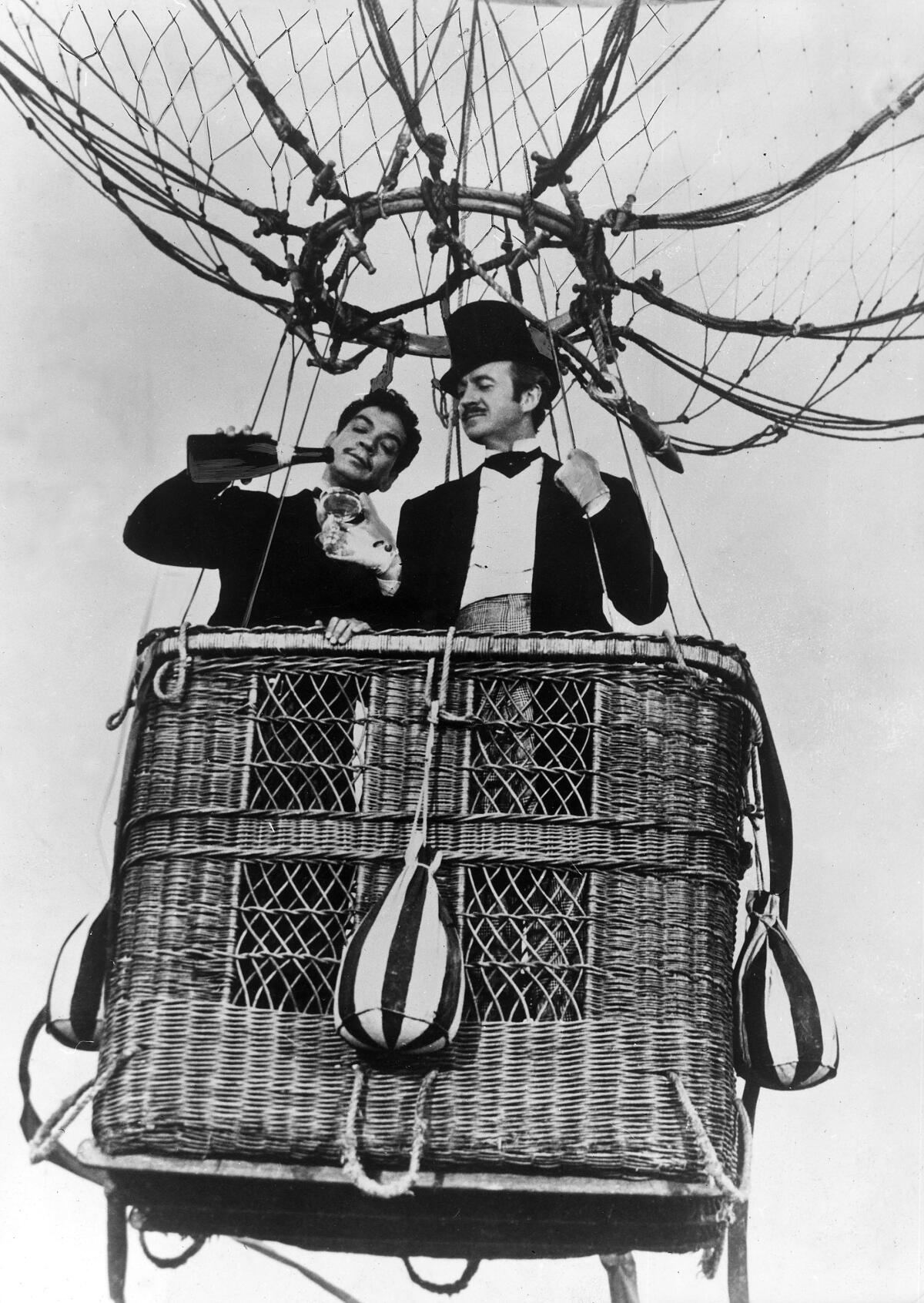From the Archives: ‘Around the World in 80 Days’ built on antic delight

- Share via
When Phileas Fogg and his servant Passepartout, their around-the-world journey begun, are sailing over the mountains that separate France and Spain, their balloon basket swoops close enough to a crag to enable Passepartout to scoop up a pailful of snow. He then produces a bottle of champagne from nowhere and places it in the pail to cool.
In another jiffy, he and his master, sky high, are toasting one another and the success of their venture.
This is as good a scene as any with which to attempt to convey something of the antic spirit of “Around the World in 80 Days.” Mike (Michael) Todd created it for his own amazement, and now a sizable portion of that same world is starting to share it. Next Saturday evening, Los Angeles will join with New York in discovering its assorted delights.
The three things that make Todd’s picturization of Jules Verne’s prophetic novel of 1872 seem so fresh and different are the way in which it has been approached, the blown-up technical attractions and the surprises in the casting of the 40-odd “cameos” who pop up where and when you least expect them.
The approach is tongue-in-cheek — most of all, probably, in the deadpan screenplay of humorist S.J. Perelman, as directed by Michael Anderson, and in the ditto interpretation of it by David Niven as Phileas Fogg and Mexico’s Cantinflas as Passepartout.
They have made a triumphant virtue (always a risky business) of the cliché, and in techniques as far apart as their training — Niven as the apotheosis of the Englishman who understates it in words, Cantinflas as the sad eternal clown who pantomimes it in actions.
The technical marvels lie in the magnification of everything by Todd-AO, the widescreen process which was first employed for the roadshow engagements of “Oklahoma!” as — and this will give you an idea of the camera’s scope — the two rounders travel from London to London via Paris, Figueres (Spain), Marseille, Suez, Bombay, Kholby, Allahabad, Calcutta, Bangkok, Hong Kong, Yokohama, San Francisco, America west to east, New York and Liverpool.
Murrow introduction
Their modes of locomotion, in addition to the balloon, include bicycle, boat, train, ships, railways, elephant, ostrich, rickshaw, stagecoach, sailmobile and hansom cab.
In their peregrinations, master and man acquire an Indian maharani, Shirley MacLaine, whom they snatch from her funeral pyre, and a police inspector, Mr. Fix — even though they strongly suspect that they are the pair he is out to inspect.
Fix is portrayed by a remarkably toned-down Robert Newton, but his performance is still amusing enough to underline our loss in his recent passing.
These four are starred; the 40 others are cameos, and alphabetically they range all the way from the B of Charles Boyer to the W of Harcourt Williams. As Todd has stressed, they are here because the parts fit them and they the parts, not as token walk-ons in name only. l leave any further recognition of them to you — it’s more fun like that.
Todd’s show, as he calls it, and which it is — runs about three hours with an intermission.
It incorporates an introduction by Edward R. Murrow, a la Cinerama, in which he reminds us graphically of “this shrinking planet”; a reissue of George Melies’ “A Trip to the Moon” (circa 1890); and a presentation of all the picture’s credits, in cartoon form, at the very end, that is the cleverest thing of all.
“Around the World” is not an unmitigated joy. It has its imperfections. One of these is a constant tendency to emphasize travelogue, to linger over pretty pictures at the expense of narrative interest; in fact it takes the good old West, the same West of puffing little train, Indians and the cavalry that have enlivened 1,000 other movies, really to snap this one into its cinematic stride.
Transitions lag
Also, the transitions from actual exotic locales to their Hollywood duplicates were not always quicker than the eye — this eye, at least. And quite a good many of the spoken lines — due to both the diverse accents and the idiosyncrasies of stereophonic sound — escaped the ear.
Other sounds — noting especially the tuneful and atmospheric score by the late Victor Young — came over with uncanny dimensions of hi-fi. And the wraparound Todd-AO screen, while it may not put you in the picture as embracingly as does Cinerama and while it has the same disturbing Cinerama habit of running uphill at the sides, boasts one distinct advantage — its 70-millimeter frame is whole, not divided against itself.
In the face of the general enchantment, however, these criticisms become more parenthetical than particular. Mike Todd’s show has something in it for everybody, but perhaps most of all for the children.
For them it opens up a new wonderland — as it did overwhelmingly, to the accompaniment of their ecstatic laughter, at the performance I was fortunate enough to attend.
More to Read
Only good movies
Get the Indie Focus newsletter, Mark Olsen's weekly guide to the world of cinema.
You may occasionally receive promotional content from the Los Angeles Times.










